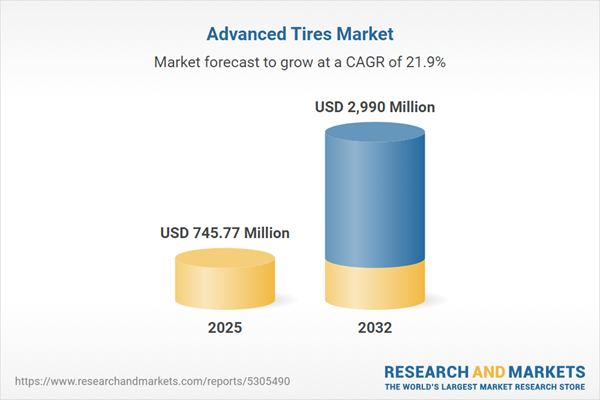Speak directly to the analyst to clarify any post sales queries you may have.
The advanced tires market is quickly evolving, shaped by accelerating digital transformation and shifting demands across global automotive supply chains. Senior decision-makers need real-time, practical intelligence to navigate challenges presented by increasing regulatory scrutiny, operational risk, and innovation pressures.
Market Snapshot: Advanced Tires Market Size and Growth Dynamics
In 2024, the advanced tires market reached USD 612.36 million, and is projected to climb to USD 745.77 million by 2025, reflecting a pronounced compound annual growth rate (CAGR) of 21.94%. Continued momentum anticipates expansion to USD 2.99 billion by 2032. This strong market trajectory is fueled by increased investments in intelligent tire technologies, coupled with the integration of connected supply chain systems. Both commercial fleet managers and passenger vehicle OEMs are elevating benchmarks for quality, compliance, and operational productivity. Key drivers include heightened demand for fleet safety, reliable and sustainable procurement, as well as a growing focus on leveraging analytics to optimize tire performance and lifecycle management.
Scope & Segmentation of the Advanced Tires Market
This report addresses the priorities of leadership teams overseeing procurement, R&D, and operations, offering a comprehensive analysis of where sector trends, digitalization, and regulation are most influential in the advanced tires market. Deep segmentation provides actionable insights into adoption rates, product strategies, and shifting procurement objectives across relevant customer and industry segments.
- Vehicle Types: Explores commercial bus, truck, and diverse passenger car classes, mapping evolving usage patterns and highlighting aftermarket service requirements.
- Tire Construction: Analyzes bias and radial tire formats, detailing their impact on dependability, lifecycle optimization, and value delivery within fleet-dominated operations.
- Tread Patterns: Compares asymmetric, directional, and symmetric tread designs, emphasizing implications for safety, cost management, and tread longevity across industrial and consumer applications.
- Distribution Channels: Reviews key channels including aftermarket upgrades and OEM alliances, assessing their roles in driving advanced tire market adoption and integration with vehicle digital platforms.
- Applications: Focuses on use cases from routine highway operations to agriculture, mining, and construction, underlining the critical need for tire robustness to sustain continuous operation cycles.
- Regional Coverage: Covers North America, Latin America, Europe, Middle East, Africa, and Asia-Pacific with a spotlight on unique procurement behaviors and regulatory climates in leading countries—such as the US, China, Germany, Brazil, India, and South Africa.
- Companies Profiled: Benchmarks leading tire manufacturers like Bridgestone Corporation, Michelin S.E., Goodyear Tire & Rubber Company, Continental AG, Pirelli, Hankook Tire & Technology, Yokohama Rubber, Sumitomo Rubber Industries, Toyo Tire, and Apollo Tyres, focusing on their innovation strategies and supply chain planning.
Key Takeaways for Senior Decision-Makers
- Sensor-enabled analytics allow proactive tire monitoring, minimizing unexpected downtime and strengthening fleet efficiency for improved operational flow.
- Collaboration between tire producers, technology companies, and original equipment manufacturers expedites the rollout of advanced digital tools and develops new business models.
- Adoption of renewable and recycled materials is increasing, meeting compliance requirements and addressing sustainability goals integral to procurement and production strategies.
- Regional manufacturing investments are enhancing supply chain resilience, enabling agility in sourcing and supporting rapid adaptation to evolving regulatory landscapes.
- Greater automation in tire production supports consistent quality and eases regulatory compliance in response to new industry standards.
- Strengthened supplier networks across global markets act as a buffer against operational disruptions and provide consistent sourcing reliability despite volatile conditions.
Tariff Impact: Navigating Policy Shifts and Global Trade Realignment
Evolving tariffs and trade policies are compelling organizations to reassess sourcing plans and production locations. Senior executives are stressing the importance of diversifying supplier bases and boosting domestic production to manage procurement flexibility and contain costs. Contingency frameworks have become a core component of procurement and supply planning, helping firms ensure uninterrupted supply amid regulatory transitions and economic uncertainty in the advanced tires market.
Methodology & Data Sources
This advanced tires market intelligence draws on direct interviews with senior industry leaders and comprehensive secondary research. Analytical methods employ strategic tools such as SWOT analysis, PESTEL, and Porter’s Five Forces to reveal risks, opportunities, and key operational and competitive influences affecting the sector.
Why This Report Matters: Strategic Decision Support for the Advanced Tires Market
- Enables executives to align technology and sustainability investments with market-driving trends, supporting long-term, sustainable growth strategies.
- Delivers operational teams the geographically relevant market intelligence required to address compliance and shifting demand with precision.
- Equips organizations to anticipate regulatory shifts and supply chain changes, accelerating digital transformation and network robustness in the advanced tires sector.
Conclusion: Charting the Path Forward in Advanced Tires
Senior leadership can leverage this market research to refine planning, manage regulatory risk, and identify new opportunities amid ongoing digital evolution and changing operational expectations.
Additional Product Information:
- Purchase of this report includes 1 year online access with quarterly updates.
- This report can be updated on request. Please contact our Customer Experience team using the Ask a Question widget on our website.
Table of Contents
3. Executive Summary
4. Market Overview
7. Cumulative Impact of Artificial Intelligence 2025
Companies Mentioned
The companies profiled in this Advanced Tires market report include:- Bridgestone Corporation
- Michelin S.E.
- The Goodyear Tire & Rubber Company
- Continental AG
- Pirelli & C. S.p.A.
- Hankook Tire & Technology Co., Ltd.
- Yokohama Rubber Co., Ltd.
- Sumitomo Rubber Industries, Ltd.
- Toyo Tire Corporation
- Apollo Tyres Ltd.
Table Information
| Report Attribute | Details |
|---|---|
| No. of Pages | 182 |
| Published | November 2025 |
| Forecast Period | 2025 - 2032 |
| Estimated Market Value ( USD | $ 745.77 Million |
| Forecasted Market Value ( USD | $ 2990 Million |
| Compound Annual Growth Rate | 21.9% |
| Regions Covered | Global |
| No. of Companies Mentioned | 11 |









